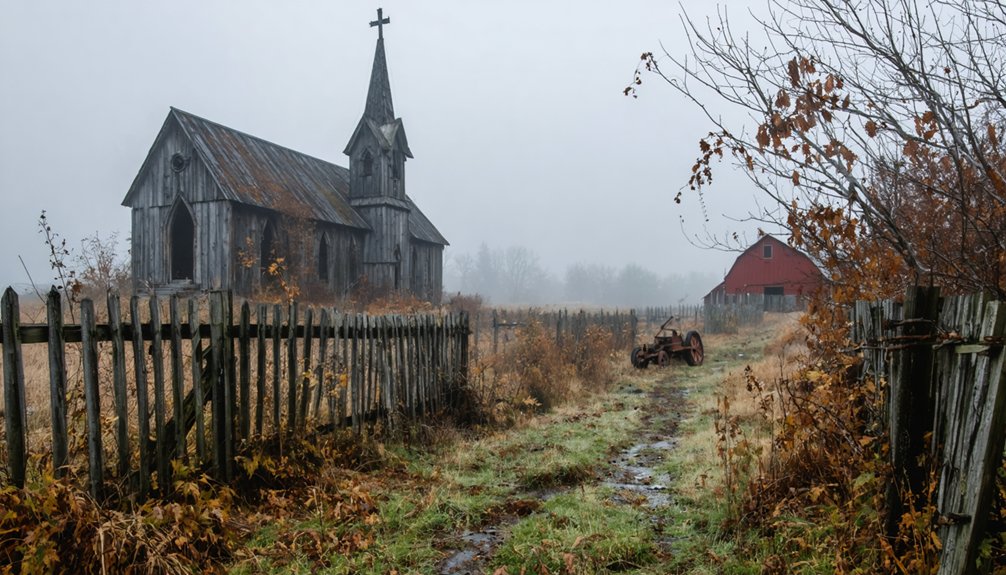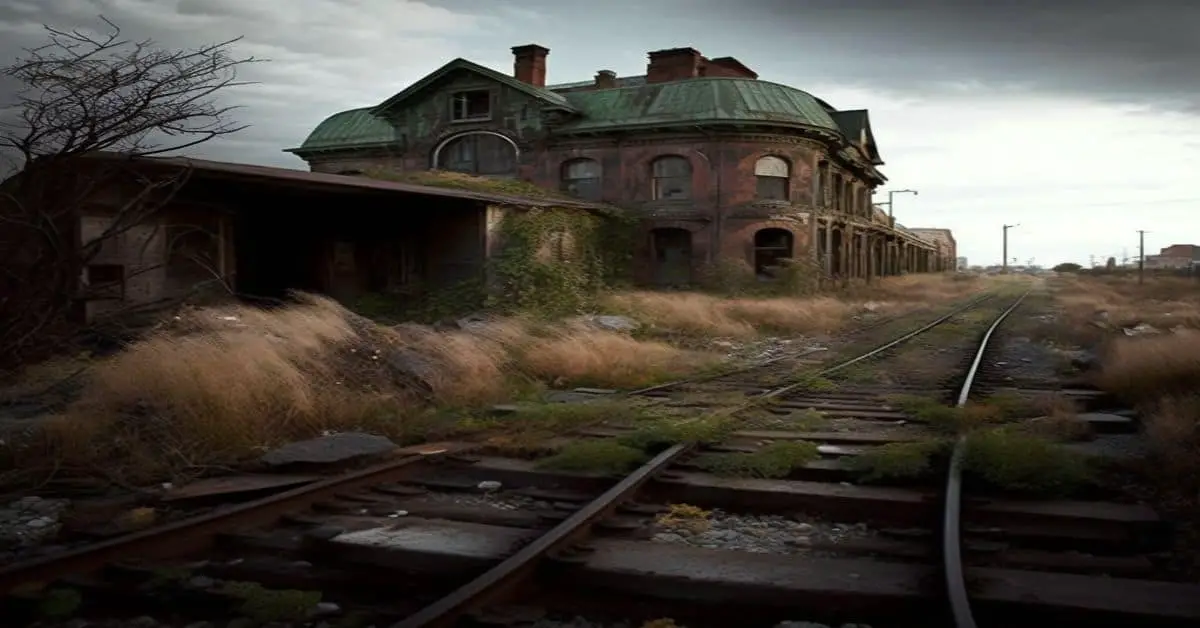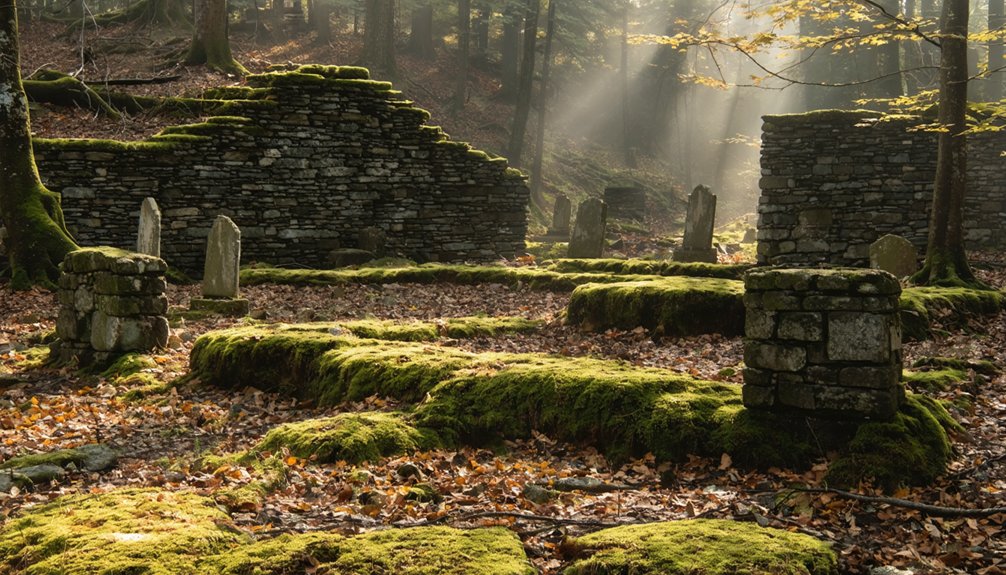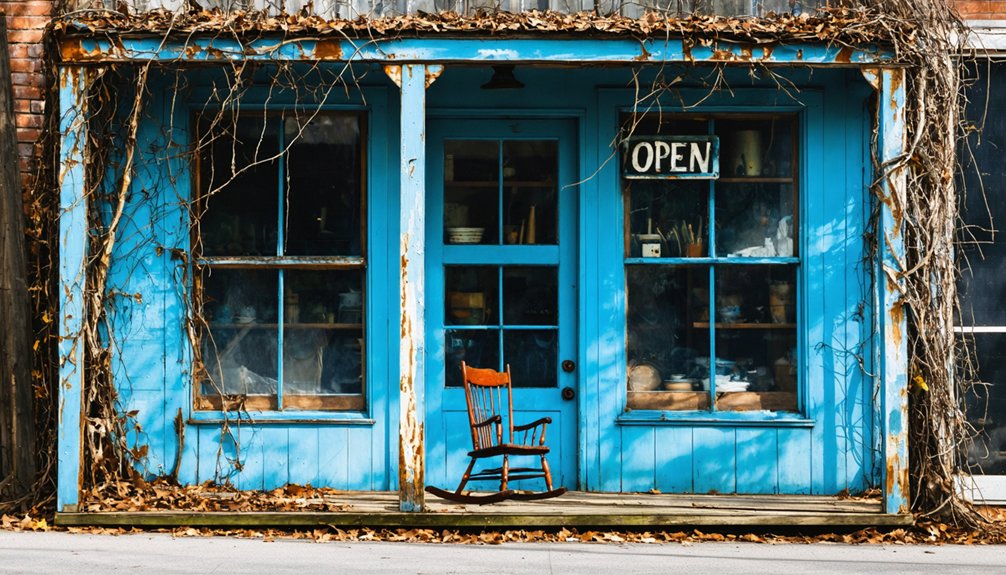You’ll find Little Danbury’s ghostly remnants in Connecticut, where the abandoned Hearthstone Castle and Vail homestead stand as eerie symbols to a colonial settlement established in 1743. The area features deteriorating historic structures, including one-room schoolhouses and farming outbuildings, all steeped in paranormal folklore. Local ghost hunters frequently investigate the castle grounds, where visitors report mysterious footsteps and shadowy apparitions. The secrets of this forgotten community run deeper than its crumbling facades.
Key Takeaways
- Little Danbury, established in 1743 as “Stony Hill,” transitioned from a thriving agricultural community to an area marked by abandoned historic structures.
- Hearthstone Castle, abandoned since 1987, stands as the most prominent ghost town feature, attracting paranormal investigators and urban explorers.
- The 1938 hurricane destroyed numerous beach cottages, marking a significant turning point in the area’s decline.
- Ongoing vandalism, insufficient preservation funding, and modern development pressures contribute to Little Danbury’s deteriorating historic landscape.
- Local ghost-hunting culture and paranormal tourism have emerged around abandoned structures, particularly the reportedly haunted Hearthstone Castle.
Early Settlement and the Stony Hill School District
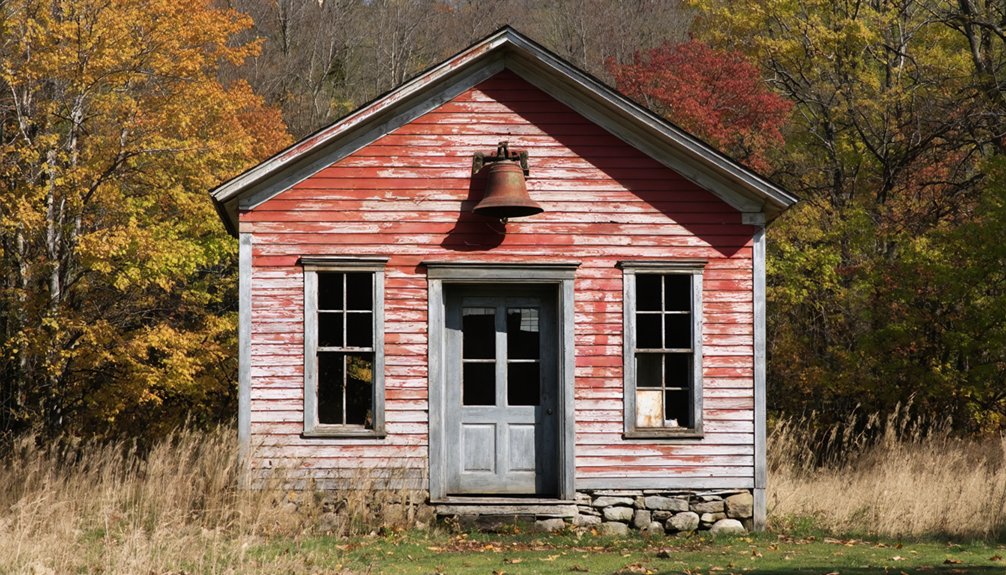
While the earliest records of Little Danbury’s settlement date back to 1743, when “Stony Hill” first appeared in probate documents, the area’s development was intrinsically tied to its strategic location near Danbury, Connecticut.
You’ll find that the region’s agricultural heritage played a crucial role in shaping the community, as family farms dotted the landscape and formed the backbone of local commerce. The area’s educational legacy was marked by a significant milestone when the original school was constructed in 1778.
Community education emerged as a cornerstone of Stony Hill‘s development, with one-room schoolhouses serving as both educational facilities and social gathering spaces.
The district’s schools, supported by local funding and community participation, reflected the area’s commitment to learning. The Paiste family sold land in 1847 that would become crucial for local education.
Despite some confusion over naming conventions, like the “Chestnut Grove” designation in neighboring areas, these educational institutions remained central to the region’s growth and cultural identity.
The Moses Vail Legacy and Colonial Architecture
Beyond the schoolhouses of Stony Hill, the colonial architecture and Revolutionary War veterans like Moses Vail left an enduring mark on Little Danbury’s landscape.
Ancient biblical names and inscriptions mark many of the headstones surrounding his plot.
You’ll find Moses Vail’s architecture preserved in his homestead, which exemplifies colonial farming life through multiple expansions and a traditional barn structure with lean-to additions. As a soldier in Connecticut’s 16th Regiment under Colonel Beardsley, Vail served his emerging nation while establishing his family’s agricultural legacy.
Born in 1748, Vail’s influence extended beyond his military service. His marriage to Hannah Benedict produced a lineage that shaped the area’s development, including their son Oliver and grandson Hiram.
Today, you can visit Vail’s final resting place in Stony Hill Cemetery, where his grave stands as a memorial to Little Danbury’s colonial heritage.
Haunting Tales From Hearthstone Castle
Since its abandonment in 1987, Hearthstone Castle‘s imposing stone walls have become a magnet for paranormal enthusiasts and ghost hunters.
Originally constructed with local granite quarried directly from the site, many believe the castle’s very foundation holds mystical properties.
You’ll encounter reports of eerie footsteps echoing through the maze-like layout of 16 rooms, while ghostly apparitions are frequently spotted near the castle’s eight stone fireplaces. Many believe the spirit of Irene Parks Jennings, the last resident, still lingers among her belongings.
The castle’s remote location in Tarrywile Park and its deteriorating wooden interiors create the perfect backdrop for supernatural encounters.
Originally designed as a honeymoon cottage for photographer E. Starr Sanford, the castle’s romantic origins add another layer to its mysterious legacy.
Paranormal investigators have documented unexplained electromagnetic disturbances and cold spots throughout the structure. While official confirmation remains elusive, the castle’s haunted reputation has inspired local artists, fueled tourism, and even spawned stories of protective spirits that ward off vandals and looters.
Abandoned Buildings and Local Legends
Across Little Danbury’s derelict landscape, two prominent structures stand as haunting reminders of the town’s gilded past.
You’ll find Hearthstone Castle, built in 1895, now deteriorating within Tarrywile Park, and the abandoned Dutch Colonial known as the House on Deer Hill. Both abandoned structures tell tales of wealth and eventual decline.
Local folklore surrounds Hearthstone Castle, where visitors claim to spot the ghost of East Star Stanford and a mysterious spectral dog.
The castle’s owner, E. Star Stanford, was a renowned portrait photographer who built the structure as a summer residence. While the castle’s haunted reputation grows through urban explorer accounts, both properties remain dangerous and off-limits to the public. Recent vandalism and a fire have further damaged the castle, while the Deer Hill House continues to rot silently.
These architectural remnants serve as stark symbols of time’s relentless march and the community’s struggle to preserve its historic treasures. The castle’s interior once showcased luxurious details with imported Italian wood throughout its seventeen rooms.
Historic Preservation Challenges and Urban Decay
You’ll find Danbury’s preservation efforts caught between modern development pressures and the urgent need to protect historic structures like Hearthstone Castle.
Limited municipal funding and gaps in community support have left many historic buildings vulnerable to ongoing deterioration, with restoration costs far exceeding available resources.
The devastating 1938 hurricane completely destroyed Little Danbury’s collection of beach cottages, serving as a stark reminder of nature’s impact on historic preservation.
Similar to Johnsonville’s fate, the installation of No Trespassing signs reflects the ongoing struggle to balance site protection with public access.
Vandals and trespassers continue to accelerate the decay of these heritage sites, undermining both their structural integrity and cultural significance.
Restoration vs. Urban Growth
The tension between historic preservation and urban development exemplifies itself dramatically in Little Danbury’s Hearthstone Castle, where decades of neglect have left this once-majestic 1890s structure in ruins.
You’ll find ongoing restoration debates centered on whether to save this architectural gem or repurpose its prime real estate.
While urban development pushes forward with new housing and commercial projects, the castle continues to deteriorate behind chain-link fences.
Failed proposals for adaptive reuse, including plans for a bed and breakfast, have stalled due to mounting costs and liability concerns. Similar to the haunted Fairfield Hills Hospital buildings, the castle’s deterioration has sparked interest from paranormal investigators.
The site’s decline mirrors Danbury’s broader evolution from its industrial past, where historic properties often lose out to modern development priorities.
Without decisive action, you’re witnessing the gradual erasure of a significant piece of local heritage.
Community Preservation Funding Gaps
Despite broad recognition of Little Danbury’s historical significance, chronic funding shortfalls have severely hindered preservation efforts throughout the ghost town.
You’ll find that limited public and private funding streams create substantial barriers to thorough restoration, while traditional preservation grants often bypass remote sites in favor of more accessible landmarks.
Current funding strategies face multiple challenges, including complex bureaucratic processes and fragmented applications that burden local preservation groups.
You’re seeing how declining community engagement compounds these issues, as demographic shifts and economic pressures reduce available resources for cultural heritage preservation.
The situation at nearby Hearthstone Castle demonstrates how funding gaps lead to accelerated decay and mounting restoration costs.
Without coordinated action and sustainable funding solutions, Little Danbury’s historical assets remain at risk of permanent loss.
Vandalism Impact on Heritage
Vandalism poses a severe and mounting threat to Little Danbury’s historic fabric, with graffiti, break-ins, and arson accelerating the decay of irreplaceable structures.
You’ll find the vandalism consequences extend far beyond surface damage – each broken window and forced entry exposes original materials to weather and pests, while stolen artifacts and defaced craftsmanship permanently diminish the site’s heritage value.
The heritage loss creates a ripple effect throughout the community.
When vandalized buildings become unsafe, you’ll see authorities restrict access, limiting educational opportunities and tourism potential.
As these historic landmarks deteriorate, they transform from proud symbols of Little Danbury’s past into visible signs of urban decay, discouraging investment and weakening community pride.
Without immediate intervention, you’re witnessing the erasure of irreplaceable historical features that tell your town’s unique story.
Paranormal Activities and Cultural Impact
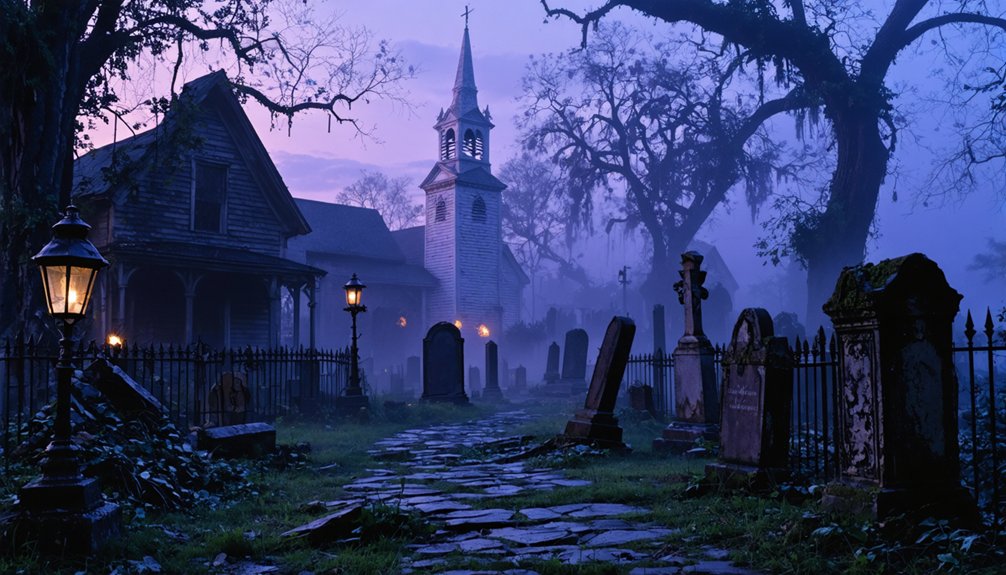
You’ll find Hearthstone Castle at the heart of Little Danbury’s supernatural reputation, where documented paranormal activity has spawned decades of ghost stories and local legends.
The castle’s haunted legacy intertwines with broader regional folklore, including tales from nearby Dudleytown and the former Fairfield Hills State Hospital.
Today’s ghost-hunting community actively investigates these sites, contributing to an ongoing cultural narrative that draws paranormal enthusiasts and tourists to the area.
Supernatural Legends Take Root
While the abandoned structures of Little Danbury hold their own historical significance, none have captured the public’s imagination quite like Hearthstone Castle, a site that has become synonymous with paranormal activity since its decline in the late 20th century.
The castle’s deteriorating state and isolation have fueled supernatural legends, with paranormal folklore deeply embedded in local culture.
You’ll find the supernatural encounters at Hearthstone Castle have shaped Danbury’s identity as a paranormal hotspot:
- Local teens practicing witchcraft in the nearby woods during the early 1990s added to the site’s mystique
- Visitors regularly report shadow figures, unexplained orbs, and eerie sounds within the castle ruins
- Ghost hunting groups, inspired by regional experts like the Warrens, conduct investigations that reinforce the site’s haunted reputation
Historic Hauntings Still Persist
Despite preservation challenges, the historic hauntings of Little Danbury continue to captivate both locals and visitors through documented paranormal activities.
You’ll find ghostly encounters frequently reported at sites like Hearthstone Castle and the Old Jail, where spectral sightings have become part of the town’s identity. These haunted locations now attract paranormal investigators and curious tourists year-round.
Local ghost hunting expeditions regularly explore these historic structures, documenting unexplained phenomena and adding to the town’s supernatural legacy.
You can join organized tours that showcase Danbury’s most active paranormal hotspots, particularly during Halloween season. The persistent reports of otherworldly activity have transformed these deteriorating historical landmarks into cultural touchstones, sparking both tourism interest and preservation efforts within the community.
Modern Ghost-Hunting Community
The vibrant ghost-hunting community of Little Danbury has transformed local paranormal investigation into a cultural phenomenon.
You’ll find dedicated investigators regularly exploring iconic haunted locations like Hearthstone Castle and the Old Danbury Jail, capturing EVP recordings and documenting unexplained phenomena.
The town’s rich paranormal events calendar features:
- Seasonal ghost walks and tours that blend supernatural exploration with historical education
- Social media-organized meetups at known haunted hotspots
- Annual Halloween investigations that draw both locals and tourists
This thriving paranormal culture has sparked preservation efforts for historic sites and created a unique tourism sector.
The legacy of the Warrens, famous paranormal investigators from the region, continues to inspire new generations of ghost hunters seeking evidence of supernatural activity.
Frequently Asked Questions
What Transportation Routes Connected Little Danbury to Neighboring Colonial Settlements?
You won’t find historical pathways linking Little Danbury to colonial trade networks. The area lacked formal roads, bridges, or ferry routes during colonial times, developing much later as a seasonal beach spot.
Are There Documented Native American Settlements or Artifacts in Little Danbury?
While you’ll find native artifacts throughout greater Danbury’s settlement history, there’s insufficient archaeological evidence to definitively confirm specific Native American settlements within Little Danbury’s precise boundaries.
What Happened to the Original Residents When Little Danbury Declined?
You’ll find that original residents scattered as their community declined, relocating to larger Connecticut cities for jobs, moving to nearby farms, or adapting to rural life while younger generations sought opportunities elsewhere.
Were There Any Operating Businesses or Industries in Little Danbury?
Like a puzzle with missing pieces, you’ll find limited records of Little Danbury’s business history. The local economy likely centered on hatting and textile industries, similar to neighboring Danbury’s manufacturing operations.
How Accessible Is Little Danbury to Modern-Day Visitors and Ghost Hunters?
You’ll find limited accessibility since there aren’t any ghost tours or visitor accommodations. The site lacks preserved structures, and you’re restricted to exploring natural landscapes subject to local coastal regulations.
References
- https://www.bethelgrapevine.com/articles/haunted-by-stony-hills-past
- https://patch.com/connecticut/danbury/connecticuts-most-haunted-places-includes-danbury-castle-0
- https://i95rock.com/44-images-from-inside-the-haunting-historic-old-jail-in-danbury/
- https://en.wikipedia.org/wiki/Hearthstone_Castle
- https://www.damnedct.com/hearthstone-castle-danbury/
- https://danburycountry.com/the-most-haunted-places-in-and-around-greater-danbury/
- https://kristipetersenschoonover.com/2013/11/06/abandoned-danbury-the-house-on-deer-hill/
- https://i95rock.com/mystery-of-dudleytown-ct/
- https://soleburyhistory.org/on-line-exhibits/interactive-maps/schools-before-1937/stoney-hill-school-1847/
- https://walkerhomeschoolblog.wordpress.com/2023/12/18/stony-hill-school-windsor-ct/
